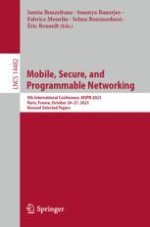2024 | Buch
Mobile, Secure, and Programmable Networking
9th International Conference, MSPN 2023, Paris, France, October 26–27, 2023, Revised Selected Papers
herausgegeben von: Samia Bouzefrane, Soumya Banerjee, Fabrice Mourlin, Selma Boumerdassi, Éric Renault
Verlag: Springer Nature Switzerland
Buchreihe : Lecture Notes in Computer Science
